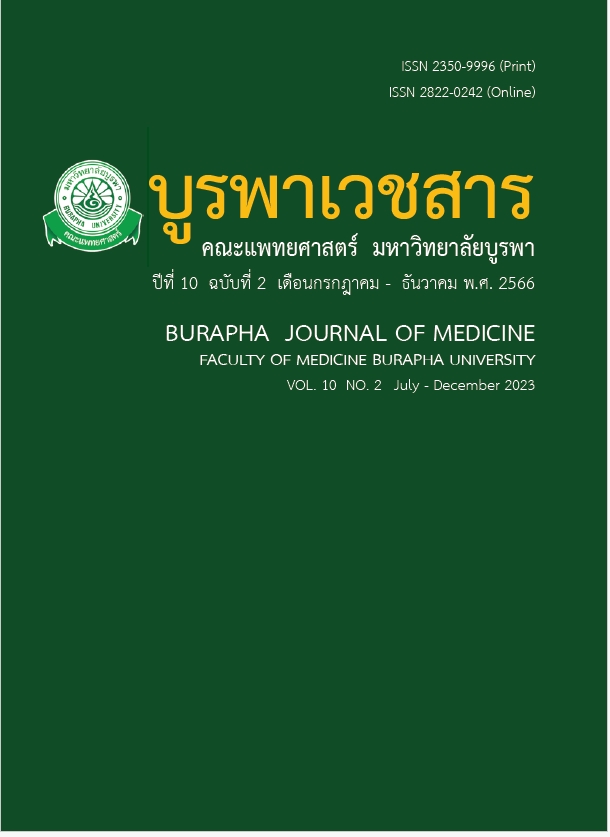ประสิทธิผลและความปลอดภัยในการฉีดแอลกอฮอล์โดยใช้อัลตราซาวนด์นำทางไปยังเส้นประสาทมัสคิวโลคิวทาเนียสในผู้ป่วยหลอดเลือดสมองที่มีกล้ามเนื้องอข้อศอกหดเกร็ง การศึกษาแบบย้อนหลัง
คำสำคัญ:
โรคหลอดเลือดสมอง , ภาวะเกร็ง , การฉีดสารละลายโดยใช้อัลตราซาวนด์นำทางบทคัดย่อ
บทนำ ปัจจุบันมีการฉีดสารละลายแอลกอฮอล์ไปยังเส้นประสาทเพื่อลดอาการเกร็งในผู้ป่วยหลอดเลือดสมองอย่างแพร่หลาย แต่การศึกษาการฉีดสารละลายแอลกอฮอล์ไปยังเส้นประสาทมัสคิวโลคิวทาเนียสในผู้ป่วยหลอดเลือดสมองที่มีภาวะข้อศอกหดเกร็งมีจำนวนน้อย และยังไม่มีการศึกษาที่ใช้อัลตราซาวนด์นำทางเพียงอย่างเดียวในการทำหัตถการนี้
วัตถุประสงค์ เพื่อศึกษาประสิทธิผลและความปลอดภัยของการฉีดสารละลายแอลกอฮอล์โดยใช้อัลตราซาวนด์นำทางไปยังเส้นประสาทมัสคิวโลคิวทาเนียสในผู้ป่วยหลอดเลือดสมองที่มีกล้ามเนื้องอข้อศอกหดเกร็ง
วิธีการศึกษา รวบรวมข้อมูลจากระบบอิเล็กทรอนิกส์ของโรงพยาบาลมหาวิทยาลัยแห่งหนึ่ง ระหว่างวันที่ 1 มกราคม พ.ศ. 2565 ถึง 30 กันยายน พ.ศ. 2565 ในผู้ป่วยโรคหลอดเลือดสมองที่มีภาวะศอกงอเกร็ง Modified Ashworth Scale (MAS) elbow flexor ≥ 1+ และได้รับการฉีดสารละลายแอลกอฮอล์โดยใช้อัลตราซาวนด์นำทาง ที่แผนกผู้ป่วยนอก ฝ่ายเวชศาสตร์ฟื้นฟู วิธีการเริ่มจากใช้อัลตราซาวนด์หาตำแหน่งของเส้นประสาทมัสคิวโลคิวทาเนียสในบริเวณแขนส่วนบน หลังจากนั้นฉีดสารละลายเอทิลแอลกอฮอล์เข้มข้นร้อยละ 50 จำนวน 4 มิลลิลิตร ไปยังรอบเส้นประสาทมัสคิวโลคิวทาเนียส ประเมินผลโดยใช้ MAS ระดับ 0-5, Associated Reaction (AR), pain score และผลข้างเคียงอื่น ๆ ก่อนฉีด ระยะหลังฉีดทันที ที่ 1 เดือน 3 เดือน และ 6 เดือน
ผลการศึกษา ผู้ป่วยหลอดเลือดสมองจำนวน 11 ราย อายุเฉลี่ย 58.5±13.1 ปี เพศชาย ร้อยละ 72.3 เพศหญิง ร้อยละ 27.3 ระยะเวลาหลังเป็นหลอดเลือดสมองเฉลี่ย 61±29.4 เดือน พบว่าหลังฉีดสารละลายเอทิลแอลกอฮอล์ทันที 1 เดือน และ 3 เดือน ระดับ MAS มีค่าลดลงจากก่อนฉีด อย่างมีนัยสำคัญทางสถิติ 1.7±0.6 (p < .001), 1.3±0.5 (p < .001) และ 0.86±0.4 (p < .001) ตามลำดับ ที่ 6 เดือนแม้ว่าระดับ MAS ลดลงแต่ไม่มีนัยสำคัญทางสถิติ 0.3±0.5 (p = .358) ส่วน AR หลังฉีดทันที 1 เดือน และ 3 เดือน ลดลงอย่างมีนัยสำคัญทางสถิติ 44.1±25.0 องศา (p < .001), 58.5±35.1 องศา (p = .001) และ 31.3±29.9 องศา (p = .021) ตามลำดับ แต่ที่ 6 เดือนลดลงอย่างไม่มีนัยสำคัญทางสถิติ 8.3±14.7 องศา (p = .224) คะแนนความปวดหลังฉีดทันทีอยู่ที่ 4.8±3.0 ไม่พบผลข้างเคียงที่รุนแรง เช่น การรับรู้ความรู้สึกผิดปกติ หรือ ก้อนเลือดบริเวณที่ฉีด
สรุป การฉีดสารละลายแอลกอฮอล์โดยใช้อัลตราซาวนด์นำทางไปยังเส้นประสาทมัสคิวโลคิวทาเนียสสามารถลดการเกร็งตัวของข้อศอกในผู้ป่วยหลอดเลือดสมองที่มีภาวะศอกงอเกร็งได้อย่างมีนัยสำคัญทางสถิติเป็นระยะเวลา 3 เดือนและไม่พบผลข้างเคียงที่รุนแรง
เอกสารอ้างอิง
Kuo C-L, Hu G-C. Post-stroke spasticity: a review of epidemiology, pathophysiology, and treatments. Int J Gerontol. 2018; 12: 280-4.
Keenan MA. Management of the spastic upper extremity in the neurologically impaired adult. Clin Orthop Relat Res. 1988: 116-25.
Pélissier J, Viel E, Enjalbert M, Kotzki N, Eledjam JJ. Chemical neurolysis using alcohol (alcoholization) in the treatment of spasticity in the hemiplegic. Cah Anesthesiol. 1993; 41: 139-43.
Kong KH, Chua KS. Neurolysis of the musculocutaneous nerve with alcohol to treat poststroke elbow flexor spasticity. Arch Phys Med Rehabil. 1999; 80: 1234-6.
Zhang C, Chen YT, Liu Y, Magat E, Gutierrez-Verduzco M, Francisco GE, et al. Improving botulinum toxin efficiency in treating post-stroke spasticity using 3D innervation zone imaging. Int J Neural Syst. 2021; 31: 2150007.
Ben Aziz M, Cascella M. Peripheral Neurolytic Blocks. StatPearls [Internet]. 2022[cited 20 Jan 2023]. Available from: https://www.ncbi.nlm.nih.gov/books/NBK559308
Kirksey MA, Haskins SC, Cheng J, Liu SS. Local anesthetic peripheral nerve block adjuvants for prolongation of analgesia: a systematic qualitative review. PLoS One. 2015; 10: e0137312.
Khalili AA, Betts HB. Isolated block of musculocutaneous and perineal nerves in the management of spasticity with special reference to the use of a nerve stimulator. Anesthesiology. 1967; 28: 219-22.
Neal JM, Brull R, Chan VW, Grant SA, Horn JL, Liu SS, et al. The ASRA evidence-based medicine assessment of ultrasound-guided regional anesthesia and pain medicine: Executive summary. Reg Anesth Pain Med. 2010; 35: S1-9.
Van Geffen GJ, Van den Broek E, Braak GJ, Giele JL, Gielen MJ, Scheffer GJ. A prospective randomised controlled trial of ultrasound guided versus nerve stimulation guided distal sciatic nerve block at the popliteal fossa. Anaesth Intensive Care. 2009; 37: 32-7.
McNaught A, Shastri U, Carmichael N, Awad IT, Columb M, Cheung J, et al. Ultrasound reduces the minimum effective local anaesthetic volume compared with peripheral nerve stimulation for interscalene block. Br J Anaesth. 2011; 106: 124-30.
Yoshida T, Nakamoto T, Kamibayashi T. Ultrasound-guided obturator nerve block: a focused review on anatomy and updated techniques. Biomed Res Int. 2017; 2017: 7023750.
Lee DG, Jang SH. Ultrasound guided alcohol neurolysis of musculocutaneous nerve to relieve elbow spasticity in hemiparetic stroke patients. Neuro Rehabilitation. 2012; 31: 373-7.
Gregson JM, Leathley M, Moore AP, Sharma AK, Smith TL, Watkins CL. Reliability of the tone assessment scale and the modified ashworth scale as clinical tools for assessing poststroke spasticity. Arch Phys Med Rehabil. 1999; 80: 1013-6.
Chen CL, Chen CY, Chen HC, et al. Responsiveness and minimal clinically important difference of Modified Ashworth Scale in patients with stroke. Eur J Phys Rehabil Med. 2019 ; 55: 754-60.
Kahn MB, Clark RA, Williams G, Bower KJ, Banky M, Olver J, et al. The nature and extent of upper limb associated reactions during walking in people with acquired brain injury. J Neuroeng Rehabil. 2019; 16: 160.
Dickstein R, Heffes Y, Abulaffio N. Electromyographic and positional changes in the elbows of spastic hemiparetic patients during walking. Electroencephalogr Clin Neurophysiol. 1996; 101: 491-6.
Collins SL, Moore RA, McQuay HJ. The visual analogue pain intensity scale: what is moderate pain in millimetres?. Pain. 1997; 72: 95-7.
Myles PS, Troedel S, Boquest M, Reeves M. The pain visual analog scale: is it linear or nonlinear? Anesth Analg. 1999; 89: 1517-20.
Tyng-Guey Wang W-SC, Chueh-Hung Wu. Musculocutaneous nerve. Musculoskeletal ultrasoun examination, part 32021. p. 72-83.
Matsumoto ME, Berry J, Yung H, Matsumoto M, Munin MC. Comparing electrical stimulation with and without ultrasound guidance for phenol neurolysis to the Musculocutaneous nerve. PM R. 2018; 10: 357-64.
Jang SH, Ahn SH, Park SM, Kim SH, Lee KH, Lee ZI. Alcohol neurolysis of tibial nerve motor branches to the gastrocnemius muscle to treat ankle spasticity in patients with hemiplegic stroke. Arch Phys Med Rehabil. 2004; 85: 506-8.
Elie P. Elovic, Michal E. Eisenberg, Neil N. Jasey J. Spasticity and muscle overactivity as components of the upper motor neuron syndrome. In: Bruce M. Gans, Walsh BE, Robinson LR, editors. Delisa's physical medicine & rehabilitation principles and practice 2010. p. 1319-44.
Felice S, Marcello Z, Franca Di M, Clotilde C, Daria N. Can we reduce the risk of adverse effects in selective neurolysis of the motor branches of musculocutaneous nerve? Evidence-based anatomy approach to the rescue of patients with muscle spasticity. Eur J Phys Rehabil Med. 2019; 55: 789-95.
ดาวน์โหลด
เผยแพร่แล้ว
รูปแบบการอ้างอิง
ฉบับ
ประเภทบทความ
สัญญาอนุญาต
ลิขสิทธิ์ (c) 2023 Burapha University

อนุญาตภายใต้เงื่อนไข Creative Commons Attribution-NonCommercial-NoDerivatives 4.0 International License.



